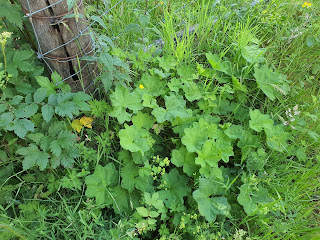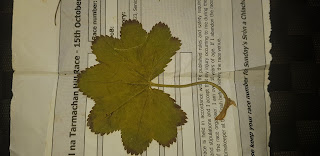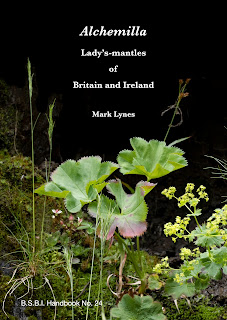I spoke to Mark Lynes, the author of the new Handbook, to find out what made him decide to devote years of his life to the study of Lady’s-mantles. Mark also provided all the images which illustrate this interview.
LM: Mark, before we start talking about the new Handbook,
could you tell us a bit more about yourself please, and how you got started as
a botanist?
ML: Well, I’m a Chartered Legal Executive by profession,
practising as a conveyancing lawyer, for many years based in Doncaster, more
recently in Lincoln. I’ve been interested in natural history for as long as I
can remember. Whilst still at school, Brian Eversham (now CEO of the Wildlife Trust for Beds., Cambs. &
Northants.) and I carried out a detailed botanical survey of a local peat
moor, which is still talked about to this day. I was even a member of BSBI back
in the day. Subsequently I was ‘lost’ to birding for around two decades,
twitching in particular – charging up and down the country chasing rare birds.
It was not until the early 2000’s that I finally came to my senses and took up
serious botany once more.
 |
| Alchemilla glaucescens |
LM: Well I’m glad you saw the light and came back to botany,
Mark! But then what drew you to Lady’s-mantles as a genus? Many of us –
especially if we are gardeners – will have an idea of what a Lady’s-mantle
looks like but may not realise that there are many different species.
ML: Well, the obvious thing for a lapsed (bird) twitcher, is
to immediately dive into rare plant twitching! Soon enough I came upon
Alchemilla. Seeing that there were only 12 native taxa, I thought ‘well, how
hard can it be?’ and was soon up in Teesdale, where I quickly discovered ‘very
hard indeed’. This would have been around 2005 and I came home from my day out
with a multitude of specimens and photographs, absolutely none of which I could
identify. This seemed like a challenge and – as I am nothing if not obstinate –
I immediately set about teaching myself to speak Alchemilla.
 |
| Mark Lynes in 'twitcher' mode with binoculars |
ML: By 2012 I had somehow come to the attention of Kevin Walker, BSBI’s Head of Science, and a meeting was suggested. We met at Doncaster railway station in early 2012, where Kevin was on a brief stopover, changing trains en route back from a school reunion do of some sort. Here, I’m afraid to say my ego rather got the better of me and when Kevin suggested I might like to ‘do the handbook’, I jumped at the chance. The fact he also dangled the prospect of a small financial grant which would enable me to go to Scandinavia to study Alchemilla was a ‘Brucie bonus’ (younger readers might need to Google that saying).
 |
| Alchemilla wichurae - close-up of the flowers |
LM: Er, you had ‘somehow come to the attention of…’? Our Head of Science is not easily impressed so you must have built up quite a reputation by that point! So, tell me a bit more about the Handbook – I know that it’s around 220 pages long, and covers 20 taxa. How many are native and how many alien?
ML: Yes, the Handbook covers 20 taxa in detail – 15 native
and five alien – four of which I recently described. An appendix includes
details of a further nine taxa which either might conceivably be found in Britain
and/ or Ireland or are otherwise relevant in some way.
LM: And descriptions of those four new taxa were published
in British &
Irish Botany, BSBI’s in-house scientific journal. The first, Alchemilla
sciura, is here,
published in 2019, and the other three species, all from northern Britain, are here,
published in 2021. When did you start working on the book?
 |
| Alchemilla glabra |
ML: The work really started with the BSBI-funded visit to
Sweden and Norway in June/July 2012, so – and as I say in the book – it has
been a long time in gestation. The actual writing process began on the 2nd of January
2016 and for this and the following two winters, I barely left the house.
Pressure of work and the desire to remain married meant I could only
realistically work at weekends. Summers were taken up with fieldwork,
collecting and photographing Alchemilla from across Britain and Scandinavia.
LM: Could you give us an example please of one of the
species you cover and what we can expect to find out from the new Handbook
about its identification, distribution and current conservation status?
 |
| Creag na caillich |
ML: Each of the 20 species covered in detail is lavishly
illustrated with numerous colour photographs illustrating all of the key
features, including leaf teeth and hypanthia, for example. Many species have
additional plates devoted to images of individual leaves, illustrating both the
variation within the species concerned and identification criteria. Each species
account begins with details of the ecology, distribution and conservation
status of the species account, most of which were prepared by Kevin Walker. For
some species – for example A. sciura – I have been able to update what we know
of the distribution of the plant, based on fieldwork conducted as recently as
summer 2021. The identification of each species is covered in great detail
also, yet is written in a relaxed, and so hopefully accessible, style
LM: You must have visited a lot of locations across Britain
and Ireland in the course of your research. Are there any that particularly
stand out in your memory?
 |
| Alchemilla neomanifesta |
 |
| Herbarium sheet of A. glabra collected by Margaret Bradshaw |
LM: Thanks Mark, I’ll let you know if I’m ever in that situation! But as well as field visits, did you visit many herbaria to look at specimens? Are herbarium specimens particularly useful when it comes to Alchemilla identification?
ML: Herbarium specimens are extremely useful in the identification of Alchemilla and the book would have been impossible without access to them. Things which are not apparent in the field, tend to reveal themselves when subjected to a 10x hand lens or similarly low-powered microscope. That said, I physically visited only two herbaria, the one at Cambridge University and one in Umeå University, Sweden. However, I did spend three days solid in the latter, working until midnight on occasion, before going out collecting Alchemilla the same night. For the majority of my specimen research, I relied on material I collected, or which was sent to me by various BSBI members and County Recorders, together with gifts of specimens and some use of herbarium loans.
 |
| Specimen of A. glomerulans sent to Mark for determination |
LM: Sounds as though you got a lot of feedback from BSBI County Recorders, our expert
referees and many of our “ordinary members” who go out plant recording. Is
there anyone in particular whose help you would like to acknowledge?
ML: Over the years I have received innumerable specimens
sent to me my BSBI members and County Recorders from across Britain and
Ireland, such that they are far too numerous to mention individually. One who
does particularly stand out, however, is Paul Smith, the County Recorder for the
Outer Hebrides (VC110). I receive
a package from Paul most years and always look forward to it as I am seeing
material from far-flung locations I have never visited, and in many cases
probably never will. One constant throughout work on the Handbook has of course
been my fellow Alchemilla referee, Dr
Margaret Bradshaw. In the early days – before work on the book commenced or
was even mooted - I attended a couple of her Alchemilla workshops held in
Teesdale. Until encountering Margaret, I was essentially self-taught in the
ways of Alchemilla. Her knowledge of the Alchemilla species of these islands is
unrivalled and I have tapped into it on every available opportunity. She’s
always been very generous with her knowledge and, more recently with literature
and specimens, some going back to the 1940’s. Within the last couple of weeks,
I went up to see her at her home in Teesdale and came home with boxes –
literally – full of papers and documents. My visit also gave me an excuse to go
and see the Red-flanked Bluetail which is wintering along the river near Wynch
Bridge (Kevin Walker will be impressed, even if nobody else is…)
 |
| Margaret Bradshaw's stomping ground in Teesdale |
LM: Hmm once a twitcher, always a twitcher…. But back to the
plants! Tell me about the illustrations: they are always an important part of
any BSBI Handbook – so, what can we expect here – photographs? Drawings? Diagrams?
And are there distribution maps?
ML: Photographs, yes. Lots and lots of photographs, over 200
in all, showing just about every conceivably useful identification feature, or
simply being very nice to look at. Whilst photos do much of the heavy lifting,
they are ably supported by ‘hair diagrams’ for each species, these illustrating
typical maxima and minima hair distribution on the leaves and
stem/inflorescence of each species
 |
| Mark's Alchemilla collection |
ML: There are two things which have – finally – made the
book happen. The first is my taking early retirement from work, thus finally
freeing up the time required to put the thing together. The second and equally
important factor, has been my editor, Jeremy Roberts. I’ve known Jeremy for a
number of years now and, for me, he was a natural choice as editor. What I did
not fully appreciate when I asked him, was just how pivotal he would be to the
whole process. Not only has he wrangled my text into something readable, he is
also responsible for the aforementioned hair diagrams, together with all the
other drawings and diagrams within the book. Without Jeremy’s input, the book
would not have been anywhere near as good as it hopefully is. I owe him a huge
vote of thanks.
 |
| A. glomerulans |
LM: Well said, three cheers for Jeremy! Thanks for talking to us about the new Handbook Mark, the 24th in BSBI’s series of Handbooks for difficult plant groups. Alchemilla: Lady’s-mantles of Britain and Ireland has been a long time coming but it looks as though it will be well worth the wait – many thanks to you and Jeremy for all your hard work and thank you for talking to me today. Before you go, may I issue an invitation to you please? Might you think of leading an Alchemilla workshop at some point, so we can all road-test the new Handbook?
ML: Yes, I am hoping
to organise an Alchemilla workshop at some point once the book is out of the
way, although it may be next year now, so watch this space!
 |
| A. filicaulis var. vestita |
LM: Thanks Mark! Now, readers will want to know how to get
hold of a copy of the new Handbook.
If you are a BSBI member, there is a flyer tucked inside the
January issue of BSBI News which you
should have received by now. It explains how BSBI members can benefit from our
exclusive offer and save £7.50 compared to the RRP of £20. You can either order
your copy by post before the end of March or else you can pay by PayPal – just click here to land on the members-only area
of the BSBI website (you'll need to have your password to hand – email me if you’ve forgotten it – and don’t
forget to include your membership number).
If you are not a BSBI member, you have two options: you will be able to buy the book from Summerfield Books and other natural history book-sellers later this spring. Or why not join BSBI and enjoy all the benefits of membership, including this special offer? It has never been quicker and easier to become a BSBI member and start getting involved.

No comments:
Post a Comment
Please leave a comment!